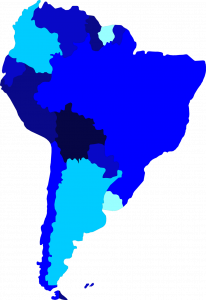Building a Remote Work Culture with Nearshored Development Teams in Latin America
Table of Contents
The COVID-19 pandemic has accelerated the trend towards remote work and virtual collaboration, making near-shoring to Latin America an even more attractive option for American companies. While remote work has many benefits, building a remote work culture can be challenging, especially when working with near-shored development teams in Latin America.
Table of Contents
In this blog, we’ll take a closer look at how to build a remote work culture with near-shored development teams in Latin America.
1. Benefits of Building a Remote Work Culture
Building a remote work culture has many benefits, including increased flexibility, improved work-life balance, and increased productivity. When working with near-shored development teams in Latin America, building a remote work culture can also help to bridge cultural and language barriers, create a sense of shared purpose and community, and foster innovation and creativity.
2. Key Strategies for Building a Remote Work Culture
Here are a few key strategies for building a remote work culture with near-shored development teams in Latin America:
2.1 Establish Clear Communication Channels:
Clear communication is critical when working with near-shored development teams in Latin America. Establish clear communication channels and protocols for sharing information, feedback, and progress updates.
2.2 Foster a Sense of Community:
Building a sense of community is important for fostering collaboration, engagement, and motivation. Use virtual team-building activities and social events to build a sense of community and shared purpose.
2.3 Emphasize Transparency and Trust:
Trust is essential for building a strong remote work culture. Emphasize transparency and trust by sharing information openly, setting clear expectations, and providing regular feedback.
2.4 Provide Professional Development Opportunities:
Providing professional development opportunities can help to keep employees engaged and motivated, and can also help to foster innovation and creativity. Offer training, mentoring, and other development opportunities to help employees grow and develop their skills.
2.5 Use Technology to Facilitate Collaboration:
Technology can be a powerful tool for facilitating collaboration and communication. Use collaboration tools like Slack, Zoom, and Trello to help teams stay connected and productive.
3. Challenges and Best Practices
Building a remote work culture with near-shored development teams in Latin America can also present some unique challenges. Here are a few best practices to help overcome these challenges:
3.1 Language Barriers:
Language barriers can present a challenge when building a remote work culture with near-shored development teams in Latin America. Use translation tools and language-learning resources to help bridge these barriers.
3.2 Cultural Differences:
Cultural differences can also present a challenge. Take the time to learn about the cultures and customs of your near-shored development team and find ways to bridge cultural differences.
3.3 Time Zone Differences:
Time zone differences can also be a challenge when building a remote work culture with near-shored development teams in Latin America. Use tools like World Time Buddy to help coordinate schedules and meetings.
3.4 Security and Privacy:
Security and privacy are also important considerations when building a remote work culture with near-shored development teams in Latin America. Use secure communication channels and implement data encryption and security measures to protect sensitive information.
Table 1: Comparison of Key Factors for Building a Remote Work Culture with Near-Shored Development
| Factor | Description |
| Communication | Establish clear communication channels and protocols for sharing information, feedback, and progress updates. |
| Community | Use virtual team-building activities and social events to build a sense of community and shared purpose. |
| Transparency and Trust | Share information openly, set clear expectations, and provide regular feedback to emphasize transparency and trust. |
| Professional Development | Offer training, mentoring, and other development opportunities to help employees grow and develop their skills. |
| Technology | Use collaboration tools like Slack, Zoom, and Trello to facilitate collaboration and communication. |
(Source: Nearshore Americas)
Table 2: Time Zone Comparison for Select Countries in Latin America
| Country | Time Zone | UTC Offset |
| Brazil | Brasilia Time | UTC-3 |
| Mexico | Central Time | UTC-6 |
| Argentina | Argentine Time | UTC-3 |
| Colombia | Colombia Time | UTC-5 |
| Peru | Peru Time | UTC-5 |
| Chile | Chile Time | UTC-4 |
(Source: World Time Buddy)
Table 3: Language Proficiency in Latin America
| Country | English Proficiency |
| Brazil | Low |
| Mexico | Moderate |
| Argentina | Moderate |
| Colombia | Low |
| Peru | Low |
| Chile | Moderate |
(Source: EF English Proficiency Index 2020)
Table 4: Common Cultural Differences in Latin America
| Country | Common Cultural Differences |
| Brazil | Formality and hierarchy |
| Mexico | Family and community orientation |
| Argentina | Direct communication style |
| Colombia | Politeness and hospitality |
| Peru | Respect for tradition and authority |
| Chile | Reserved communication style |
(Source: Nearshore Americas)
As remote work continues to become more common, building a remote work culture with near-shored development teams in Latin America is becoming increasingly important for American companies. By following these key strategies and best practices, American companies can successfully build a remote work culture that fosters collaboration, innovation, and productivity. By taking into account the unique challenges presented by language barriers, cultural differences, time zone differences, and security and privacy concerns, American companies can reap the many benefits of near-shoring development to Latin America and building a remote work culture with their near-shored development teams.
Visit our exclusive page on Hiring Nearshore Developers to learn more about finding the ideal LatAm talent for your business.
If you’re looking to hire LatAm developers remotely, take a look at our guide on the Top 7 Websites to Hire LATAM Developers in the Americas for more in-depth information.
4. Conclusion
Building a remote work culture with near-shored development teams in Latin America can be challenging, but it can also be incredibly rewarding. By establishing clear communication channels, fostering a sense of community, emphasizing transparency and trust, providing professional development opportunities, and using technology to facilitate collaboration, American companies can successfully build a remote work culture with their near-shored development teams in Latin America. By taking the time to overcome challenges related to language barriers, cultural differences, time zone differences, and security and privacy concerns, American companies can reap the many benefits of building a remote work culture, including increased productivity, engagement, and innovation.



